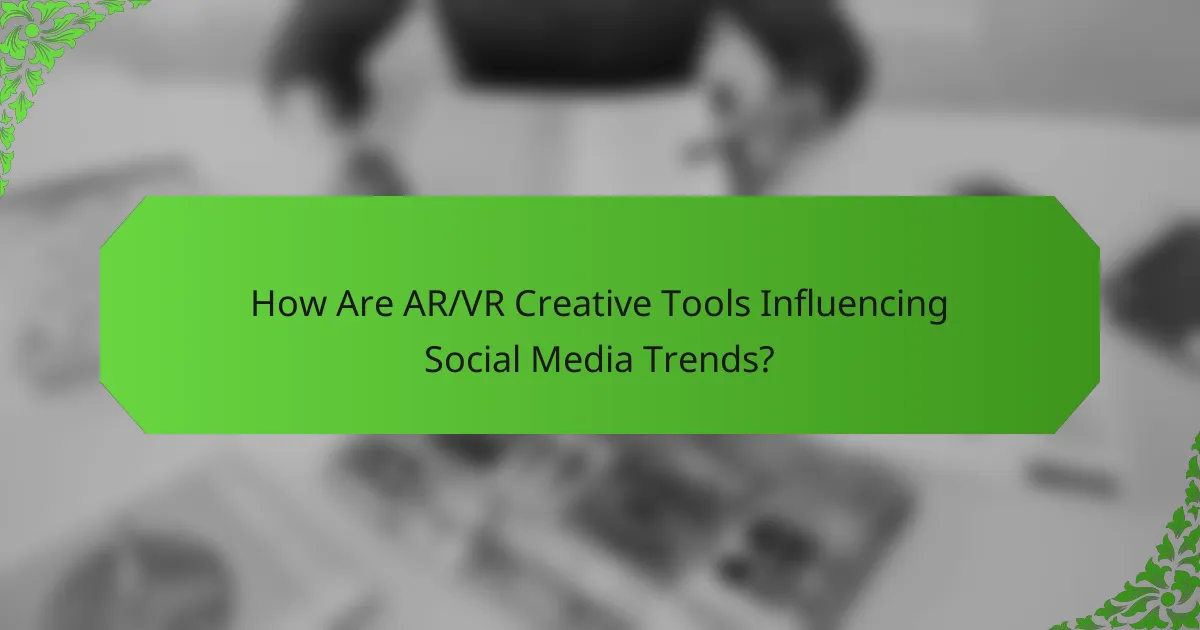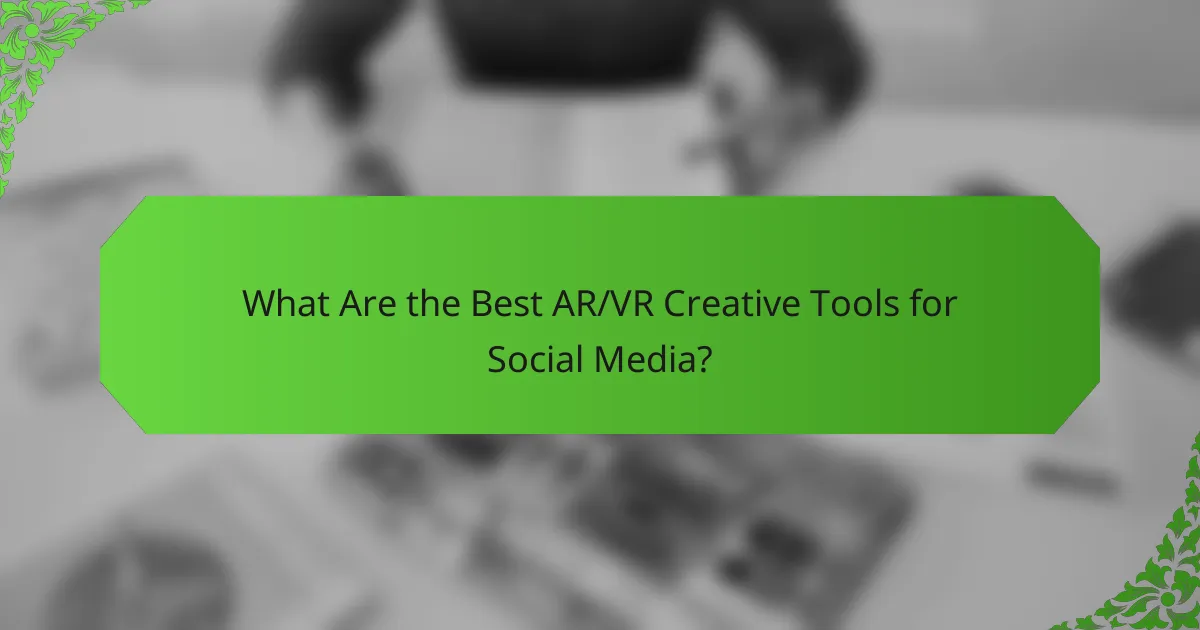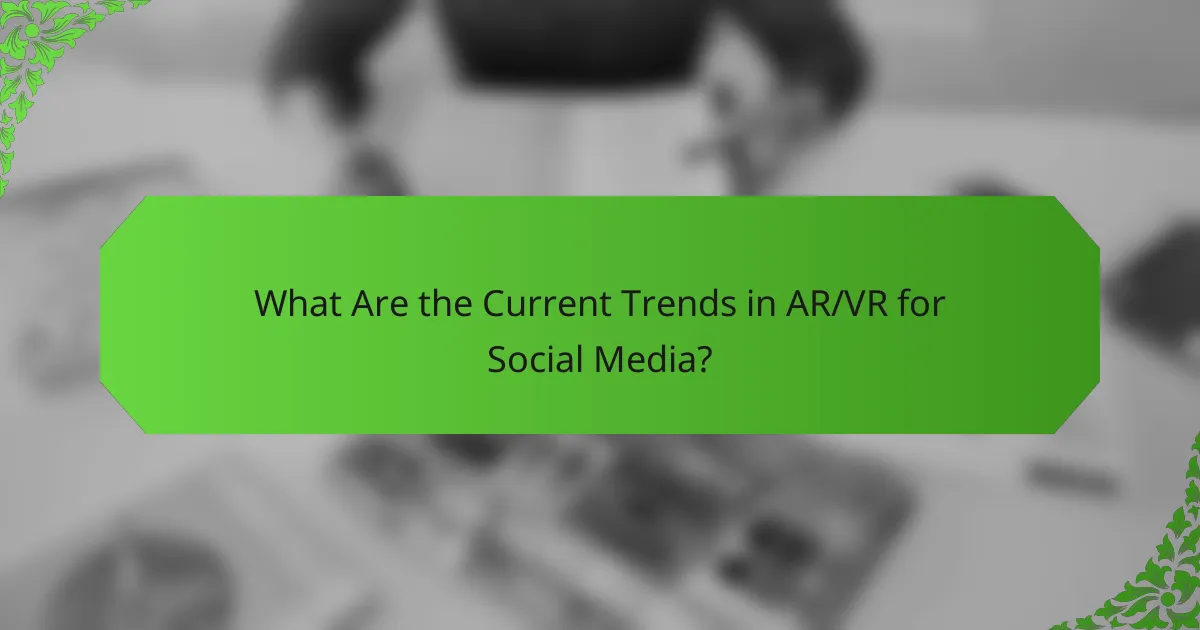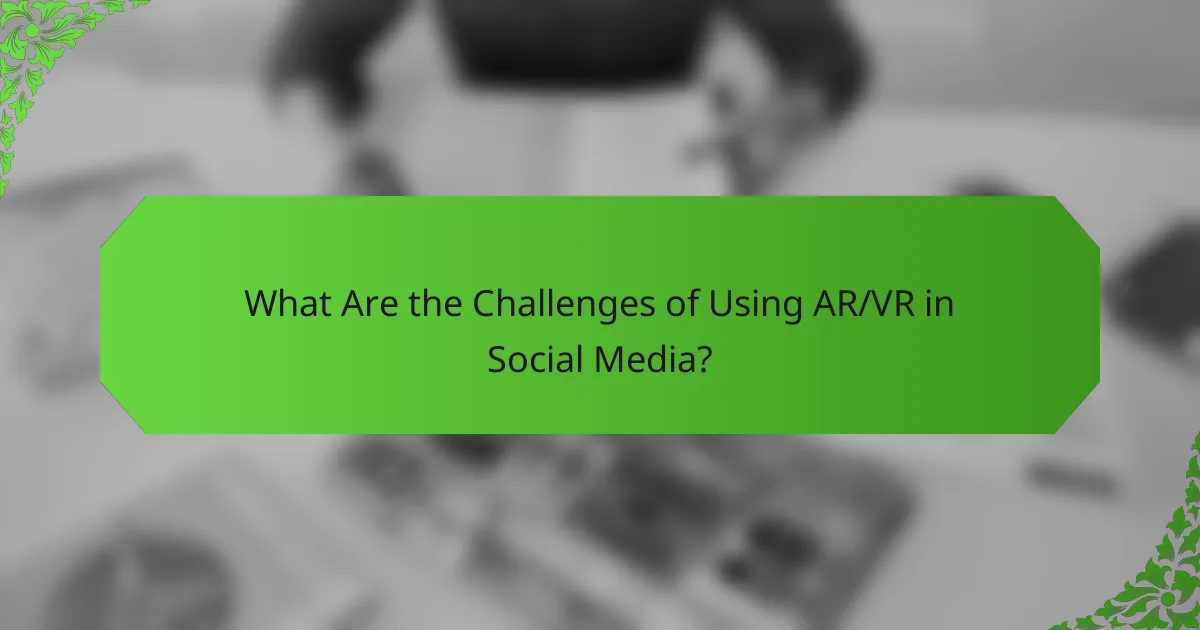AR and VR creative tools are revolutionizing social media by allowing users to craft immersive experiences that engage and captivate audiences. These innovative technologies enhance the appeal of content, making it more memorable and interactive. Selecting the right tool involves considering factors such as usability, platform compatibility, and cost, ensuring that creators can effectively elevate their projects and boost engagement across social channels.

How Are AR/VR Creative Tools Influencing Social Media Trends?
AR and VR creative tools are reshaping social media trends by enabling users to create and share immersive experiences that captivate audiences. These technologies enhance interaction and engagement, making content more appealing and memorable.
Increased engagement through immersive content
Immersive content created with AR and VR tools significantly boosts user engagement on social media platforms. Users are more likely to interact with content that offers a 3D experience or augmented elements, leading to longer viewing times and higher sharing rates.
For example, brands that utilize AR filters on platforms like Instagram or Snapchat often see engagement rates increase by substantial margins, sometimes reaching up to 80% more interactions compared to standard posts. This trend highlights the importance of integrating immersive elements into social media strategies.
Enhanced storytelling capabilities
AR and VR technologies allow brands to tell stories in a more dynamic and engaging manner. By creating virtual environments or interactive narratives, companies can convey their messages more effectively, making the content resonate with viewers.
For instance, a travel company might use VR to offer virtual tours of destinations, allowing potential customers to experience the location before booking. This not only enhances the storytelling aspect but also builds a stronger emotional connection with the audience.
Brand visibility and user interaction
Utilizing AR and VR tools can significantly increase brand visibility on social media. When users engage with immersive content, they are more likely to share it, thus amplifying the brand’s reach organically.
Moreover, interactive features, such as AR games or challenges, encourage users to participate actively, fostering a sense of community around the brand. This approach can lead to a loyal following and increased customer retention, as users feel more connected to the brand’s narrative and values.

What Are the Best AR/VR Creative Tools for Social Media?
The best AR/VR creative tools for social media empower users to create engaging and immersive content. These tools vary in functionality and ease of use, catering to both beginners and experienced creators.
Adobe Aero for AR design
Adobe Aero is a user-friendly tool designed for creating augmented reality experiences without extensive coding knowledge. It allows creators to import assets from other Adobe applications and easily animate them in a 3D space.
Key features include intuitive drag-and-drop functionality and the ability to preview AR designs in real-time. This makes it suitable for social media campaigns, where quick iterations and visual appeal are crucial.
When using Adobe Aero, focus on optimizing your assets for mobile devices to ensure smooth performance. Avoid overly complex animations that may detract from the user experience.
Unity for VR experiences
Unity is a powerful platform for developing virtual reality experiences, widely used in gaming and interactive applications. It offers extensive resources and a large community, making it a preferred choice for creators looking to build immersive content.
Unity supports various VR headsets and provides tools for 3D modeling, physics, and scripting. However, it has a steeper learning curve compared to simpler tools, which may require time to master.
For effective social media integration, consider creating short, engaging VR experiences that can be shared easily. Focus on optimizing performance to ensure a seamless user experience across different devices.
Spark AR for Instagram and Facebook
Spark AR is a platform specifically designed for creating augmented reality effects for Instagram and Facebook. It allows users to build interactive filters and effects that can enhance user engagement on these social media platforms.
The tool provides a range of templates and assets, making it accessible for creators of all skill levels. Users can also test their effects in real-time on their devices before publishing.
To maximize impact, focus on trends and popular themes within your target audience. Ensure your AR effects are easy to use and share, as this can significantly increase their reach and engagement on social media.

How to Choose the Right AR/VR Tool for Your Needs?
Choosing the right AR/VR tool involves assessing your specific requirements, including usability, compatibility with social media platforms, and pricing structures. A well-suited tool can enhance your creative projects and improve engagement on social channels.
Assessing user interface and ease of use
The user interface (UI) and ease of use are critical factors when selecting an AR/VR tool. A straightforward UI allows for quicker learning and smoother project execution, which is essential for both beginners and experienced users. Look for tools that offer intuitive navigation and clear tutorials.
Consider testing a few options through free trials or demos. This hands-on experience can help you gauge how easily you can create content and navigate the features. Prioritize tools that minimize the learning curve and maximize productivity.
Evaluating compatibility with social platforms
Compatibility with social media platforms is vital for ensuring your AR/VR content reaches the intended audience. Check if the tool supports popular platforms like Instagram, Facebook, or TikTok, as this can significantly impact your content’s visibility and engagement.
Some tools may offer built-in sharing features or templates optimized for specific platforms. Assess whether the tool allows for easy export and integration with your preferred social media channels to streamline your workflow.
Considering pricing and subscription models
Pricing and subscription models vary widely among AR/VR tools, so it’s essential to find one that fits your budget and needs. Many tools offer tiered pricing, with basic plans providing essential features and premium plans unlocking advanced capabilities.
Evaluate whether a monthly subscription or a one-time purchase is more cost-effective for your usage. Look for any hidden fees or additional costs for updates and support. Free trials can also help you determine if the tool’s value justifies its price before committing.

What Are the Current Trends in AR/VR for Social Media?
Current trends in augmented reality (AR) and virtual reality (VR) for social media focus on enhancing user engagement through interactive content. These technologies are increasingly integrated into platforms, allowing users to create, share, and experience immersive content that drives community interaction and brand loyalty.
Rise of user-generated AR content
User-generated AR content is becoming a significant trend as platforms encourage creativity among users. This allows individuals to design their own AR experiences, such as filters and effects, which can be shared widely. Brands are leveraging this trend by hosting challenges or contests that motivate users to create content featuring their products.
For example, Snapchat and Instagram have introduced tools that enable users to create custom AR filters, leading to a surge in unique, personalized content. This not only boosts user engagement but also fosters a sense of community as users share their creations.
Integration of AR filters in marketing campaigns
AR filters are increasingly being integrated into marketing strategies to enhance brand visibility and consumer interaction. Brands utilize these filters to create immersive experiences that allow users to try products virtually, such as makeup or clothing, before making a purchase.
Successful campaigns often feature branded filters that align with seasonal events or product launches. For instance, cosmetics brands frequently release AR filters that let users visualize how a new lipstick shade would look on them, driving both engagement and sales.
Growth of virtual events and experiences
The growth of virtual events and experiences is reshaping how brands connect with their audiences. With the rise of AR and VR, companies can host immersive events that allow participants to engage from anywhere in the world. This trend has been particularly prominent during times when in-person gatherings are limited.
Examples include virtual product launches, concerts, and trade shows that utilize AR/VR technology to create interactive environments. Brands that adopt these technologies can offer unique experiences that stand out in a crowded digital landscape, enhancing customer loyalty and engagement.

What Are the Challenges of Using AR/VR in Social Media?
Using AR/VR in social media presents several challenges, primarily due to high development costs and technical limitations. These factors can hinder widespread adoption and effective integration into existing platforms.
High development costs
The financial investment required to develop AR/VR content can be substantial. Creating high-quality experiences often necessitates advanced technology, skilled personnel, and extensive testing, which can lead to costs in the thousands or even millions of dollars.
Brands and creators must weigh the potential return on investment against these expenses. For smaller businesses, exploring partnerships or using existing platforms with built-in AR/VR capabilities may be more feasible than developing custom solutions from scratch.
Technical limitations and accessibility issues
Technical limitations, such as device compatibility and performance issues, can restrict user experiences. Not all users have access to the latest AR/VR hardware, which can create disparities in engagement and interaction.
Additionally, accessibility issues arise when considering users with disabilities. Ensuring that AR/VR content is usable for everyone requires thoughtful design and adherence to accessibility standards, which can complicate the development process.